Authentic Experience in Baška: Stone Drywall Workshop and Restoration
October 24, 2022 - Earlier this year, the Baška association Sinjali organised workshops and the restoration of a mrgar (stone drywall) on Ljubimer. They did it with the support of the Baška Municipality Tourist Board, the Baška Municipality, and the professional technical assistance of the 4 Grada Dragodid association. After the successful workshops held in spring, the efforts will continue this November.
If you are a fan of nature, cultural heritage and helping out - the Baška Municipality Tourist Board invite you to register for the stone drywall construction workshop that will be held on November 5 and 6, 2022 in Baška. Learn the principles of traditional stone drywall construction techniques, and enjoy the view of the sea and islands, far from the city noise and busy everyday life. The workshop is free for all participants and includes tools, protective gloves, a hot meal and expert guidance from a mentor from the association 4 Grada Dragodid.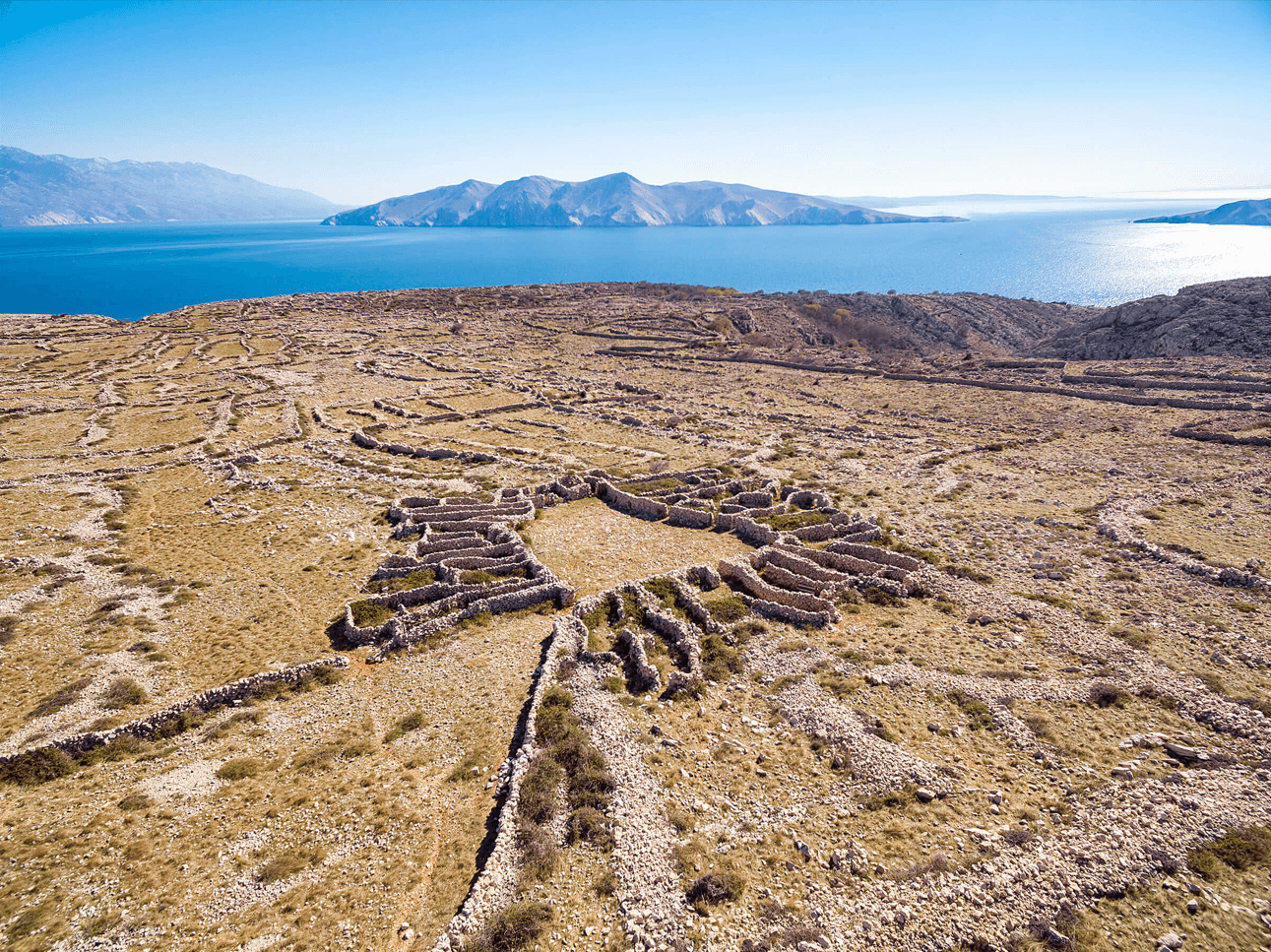
The workshop aims to restore part of the neglected mrgar, but also to encourage their further restoration and evaluation in terms of tourism, while the educational part of the programme is aimed at informing and educating the local population and visitors about the values of natural and cultural heritage and the possibilities of sustainable development that such a valuable infrastructure brings. Sign up here!
Schedule:
Saturday, November 5
08:30 - 09:00 - gathering at Zarok and distribution of tools, protective equipment and water
09:00 - departure to Ljubimer
10:00 - the start of work
15:00 - completion of works and return to Baška
16:30 - arrival in Baška
17:00 - joint dinner at Heritage Hotel Forza for all volunteers and organisers
19:30 - lectures in Zvonimir Gallery, Baška
Sunday, November 6
09:00 - departure from Zarok to Ljubimer
10.00 - 14.00 - workshop
15:30 - arrival in Baška and return of tools
16:00 - lunch at Heritage Hotel Forza and distribution of certificates of appreciation

Lectures:
1. All our mrgars - lecturer Branka Polonijo, Sinjali Association
PP presentation with photos of all mrgars, locations, functions, conservation, presentation, protection and tourism valorisation
2. Drywall construction and renovation techniques - lecturer Filip Šrajer, 4 Grada Dragodid Association
Photographs and drawings will present the most common forms of stone drywall constructions, the basic principles and the most common mistakes in stone drywall construction and the reconstruction of destroyed parts of drywalls.
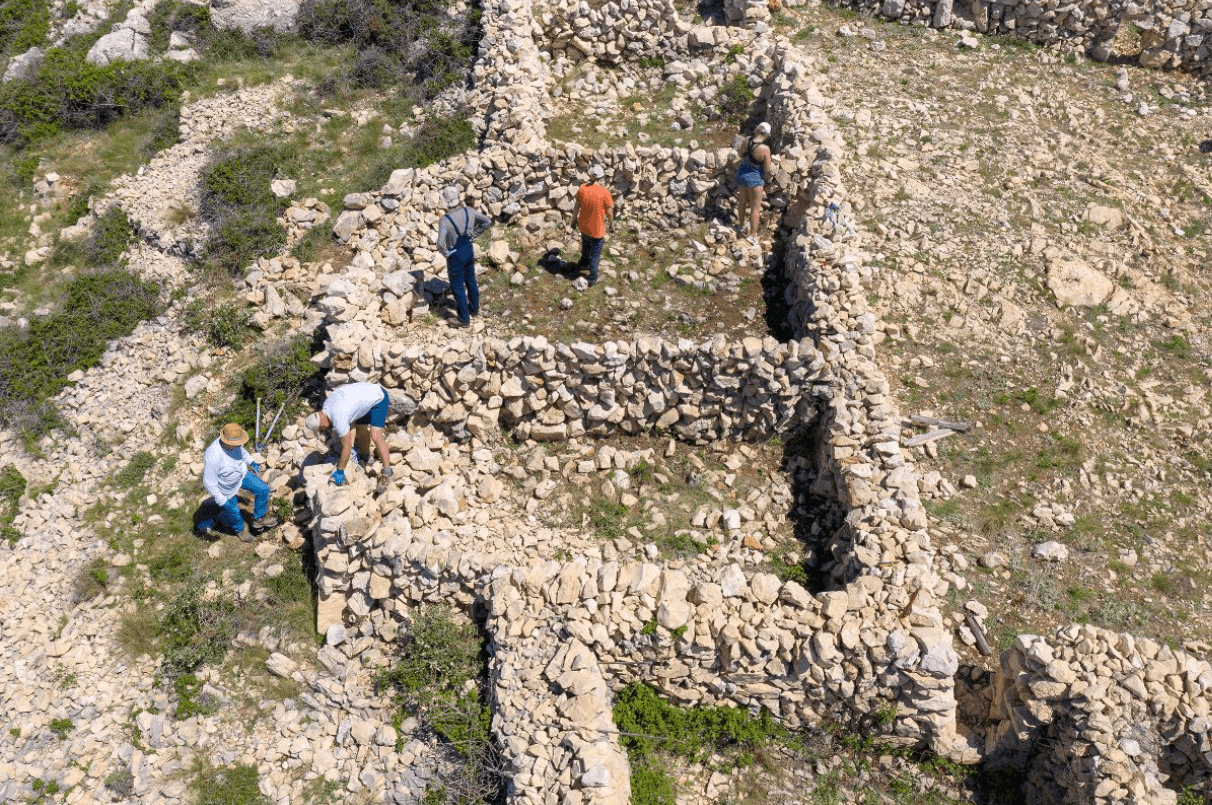
With their unique structure, which resembles a stone flower, mrgars are a recognisable decoration of the pastures (komunade) of Baška, Jurandvor and Batomalja, or at least they should be, which is the purpose of these reconstruction workshops. The speciality of these stone laces is that you can only find them on the southern part of the island of Krk. There are ten of them, five on each plateau and another five on the neighbouring island of Prvić. This way of breeding sheep was used in Wales in Great Britain, and there are two further mrgars on the uninhabited island of Dolin (near the island of Rab) and one in Switzerland!
This Krk rhapsody in stone was once created by the shepherds of Baška, Batomalj and Jurandvor, not as an artistic intervention in the landscape but as a functional object in the service of collecting and sorting sheep in the collective type of sheep farming. The mrgars consist of a common central space of the hall and, like the petals of a flower, arranged mrgarići (smaller drywalls) that the shepherds individually own.
Due to the changes in sheep farming in recent decades, the mrgars have lost their primary purpose and have been left to the test of time. However, they are part of the cultural heritage of the island of Krk and, as such, should survive for all future generations, and this is precisely the wish of the organisers of this action.
They invite all interested locals, visitors and fans of Baška to participate in a two-day workshop on stone drywall construction, an important part of the heritage of the Baška region. All help is welcome!
For more, make sure to check out our dedicated Lifestyle section.
Poetry As Preservation of Slavonian Cultural Heritage and Tradition
31st of March 2022 - Meet Željko Čuljak, whose poetry and stories about the beauty of Slavonia and its residents aim to preserve the cultural heritage and tradition of his village Cerić and the whole Slavonian region.
We spoke with Željko in his home in the small village of Cerić, which is located near Vinkovci and has suffered a tragic fate. During the Homeland War, Cerić fell and was destroyed to the ground - residents lost everything and inevitably fled the enemy aggression which destroyed everything in their way. Željko, with his fellow fighters and villagers, stayed behind and helped to protect Nuštar, a nearby village that resisted tireless enemy attacks and led bloody battles that lasted for days. On the 5th of October in 1991, just a few days after surrounding villages fell to the enemy hands (Cerić and Marinci), Croatian defenders resisted enemy attacks and, in the end, managed to protect the village from aggressors. This event is forever inscribed in the history books of the Homeland War as the “Battle of Nuštar”, which was one of the biggest wins of the Croatian army in an effort to protect the country of Croatia from aggressors. Why is this event mentioned? Because its consequences left a big scar on Cerić and its surroundings - destroyed homes, displacement of the residents, destroyed the most recognizable symbol of the village, the church and so much more. The identity of the village was shattered by those buildings and still has an impact on the village's atmosphere today. However, returnees to the village and new residents made it their mission to bring back the old glory of Cerić, promote how people lived before the war, and show that their tradition, cultural heritage, and their lives were not erased on that fateful day in 1991.
Thus, join us in meeting Željko, who is at forefront of the mini “Slavonian revolution” which is propelled by his stories and poetry about the past and present and the future of Slavonia as well.
Željko, can you tell TCN readers a bit about yourself?
My name is Željko Čuljak, a folk poet and a writer, a defender of the Homeland War and a retiree, who in their free time raises pigeons and writes stories about Cerić and Slavonia. I am a father of three children, a grandfather, and a husband. My writing is connected to the exile of our village, ten years of watching my village from the frontlines. To understand my writing and me in general, you need to see where I live.
What is Cerić? If you look at it as an outsider it seems like any ordinary Slavonian small village, so what is so special about it to you?
We live in Slavonia, a rich and “full” region that through time attracted a lot of conquerors and consequently, misfortunes. People who lived here suffered a lot during a few wars that happened in this region and after those casualties, the number of residents rapidly decreased which led to people all over the country migrating to Cerić. In the beginning, a lot of conflicts occurred between immigrants and the old residents, who felt threatened by the newcomers. However, after some time, harmony and love prevailed and connected these different groups. Love won in the end and those newcomers accepted the village's customs and cultural heritage and traditions of this region. In conclusion, calm people live here.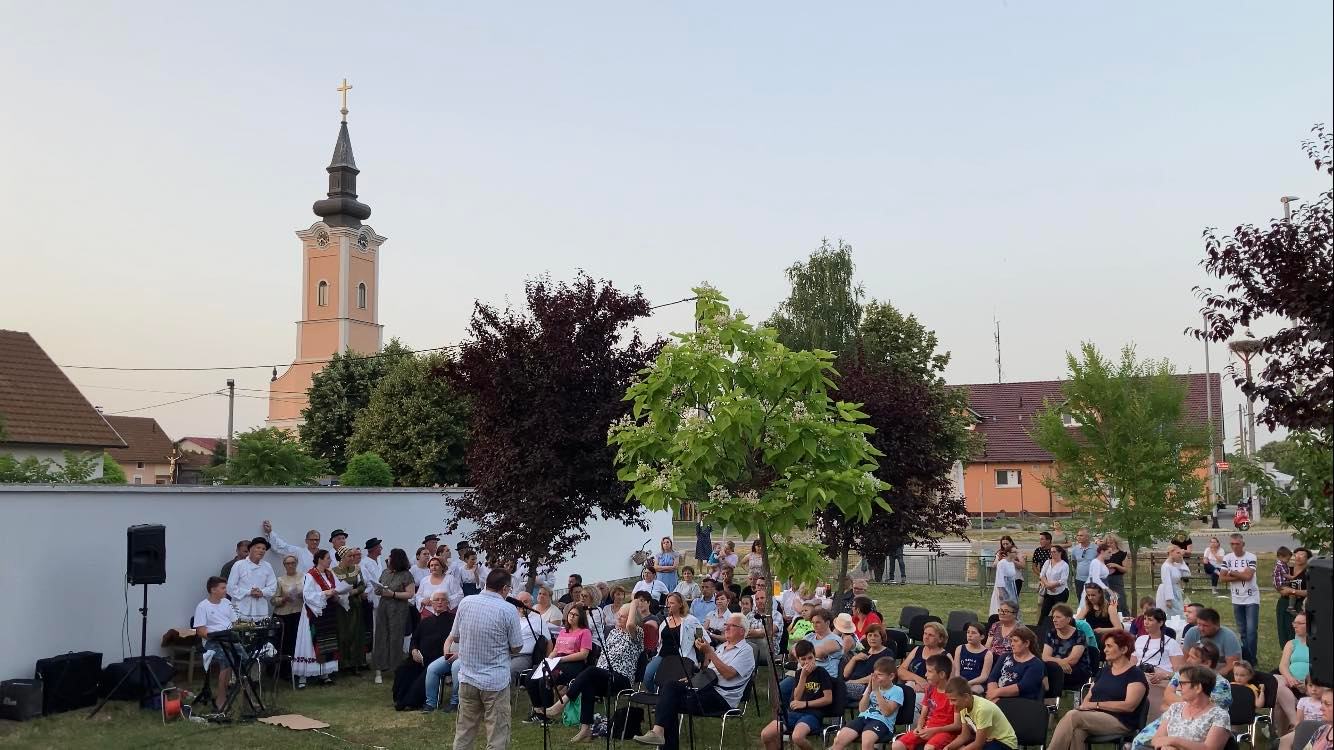
"Evenings with Poetry" in Cerić, (photo credit: Vedran Čuljak)
When did you discover your passion for writing?
I don’t talk much, a lot of the things I prefer keeping to myself and we were taught “if you don’t have anything nice to say, it’s better for you to be quiet.” I endured the war better while I was in it than when I came back to destroyed homes and a neglected village, it fuels the anger in you. That site slowly but surely built up anger and rage in me and I couldn’t express it to others nor me. Then, one time at the mass, I heard a priest talking about anger and saying: “Love your enemies, forgive!” How can I do that?! I realized that I need to forgive myself to let go of that anger. When I’m surrounded by so many good people, how can I be angry?! And those experiences fueled my inspiration for writing. Firstly, I started writing for myself. I write about the beauty and happy adventures of our lives and their residents. I felt sorrowful for not sharing my work with anyone, so I started gifting and selling my work to family and friends. When they liked and praised my work, I felt like I was doing something right. Also, I am part of the Folklore Society of Cerić "Slavko Mađar" and they always need new ideas or “old” ideas I realized that war kind of erased part of our history, people who “disappeared” from this place took the tradition and cultural heritage with them. Today, I’m sort of a keeper of memories in Cerić, one of the people who bring those old stories and memories back to residents and it, unfortunately, seems that people forgot most of them. I try my best to save and preserve that cultural heritage for children of the future. We have a very nice combination of us poets who write and the rest of the village who “absorb” everything we make. We give our poetry soul and actors from Folklore give them life.
Željko, do you think there are enough of these initiatives that have the mission of preserving and promoting Slavonian cultural heritage?
Folklore Societies are keepers of tradition and it’s well represented, not just in our region but throughout all of Croatia. Every village and town have their own Folklore Society. The question is, are people aware of them? Once upon a time, people were actually running away from tradition and it was an embarrassment to even be connected to these groups because everything else foreign was better. Then we realized during War that we miss sitting under the old mulberry tree while the spring sun is shining, harvesting our own crops and so many more things that make this region unique. Simply, all of the residents of Cerić realized that that’s the point - it’s nice to go abroad to a beautiful country or city but in the end, there is no place like home.
Do you have any of your original work published?
I have a collection of poems called Trace of The Soul (Trag Duše) which came out in 2019. It’s mostly poems about the war we experienced, adventures, and traditions Cerić offered and inspired me to write about. I wrote another book of poetry expected to be published near the end of the year, it should’ve been published before but COVID-19 slowed down the process. It’s easy to write for me since there’s a lot of inspiration around me like children going back from school, the boy who’s a head shorter than the girl but still carries her bag, and those kinds of stories make my writing worthwhile. Everything is simple and lively in this village.
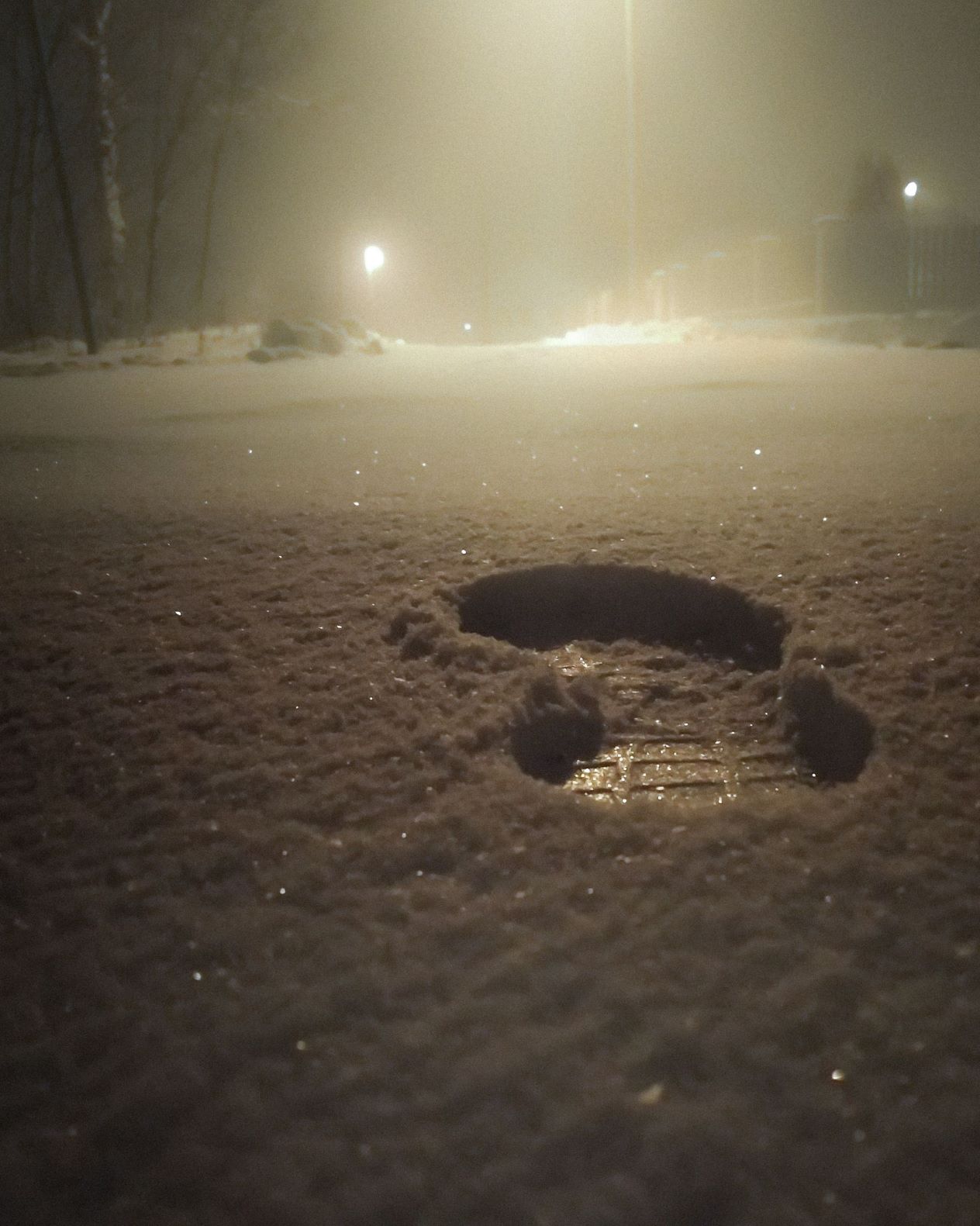
Original cover of "Pattern of the Soul" (Trag duše), Željko's published work, (photo credit: Vedran Čuljak)
Who’s your biggest critic?
My wife is my eternal inspiration to me haha AND my biggest critic of course. Everything that works and everything that doesn’t work she always tells me. She knows how to read my poem better than I! I don’t know how to interpret it when I write it! To me, it’s a blessing and brings me a lot of joy when every poem finds its own role, every person finds themselves in my poem, my story. We are extremely lucky that our whole village participates with us.
Can you tell us the events or manifestations that you organize every year in your village?
We have “Evening of Poetry” which is usually held during summertime at the end of June. It’s part of the celebration of our saint of the village, Ivan (John), or how we say it here, Ivanje. Usually held in the evening, residents gather and light up the torches, we sit on bales of straw in the middle of Cerić and recite our poems and stories. Residents and our guests also participate in the event and it’s such a beautiful celebration of Slavonian cultural heritage and traditions. We have one more event, the “Yearly concert of Folklore Society” which is held around Municipality Day of Nuštar. Local people criticized this manifestation since it was held on 2nd of the October which was the day Cerić fell in the Homeland War. We were accused of celebrating the biggest tragedy this village experienced in its history. What they didn’t understand is that we always celebrate life, coming back to our homes, all of those people who were exiled or have left us for other reasons and we do it with songs, socializing, being happy and that’s the most important part.
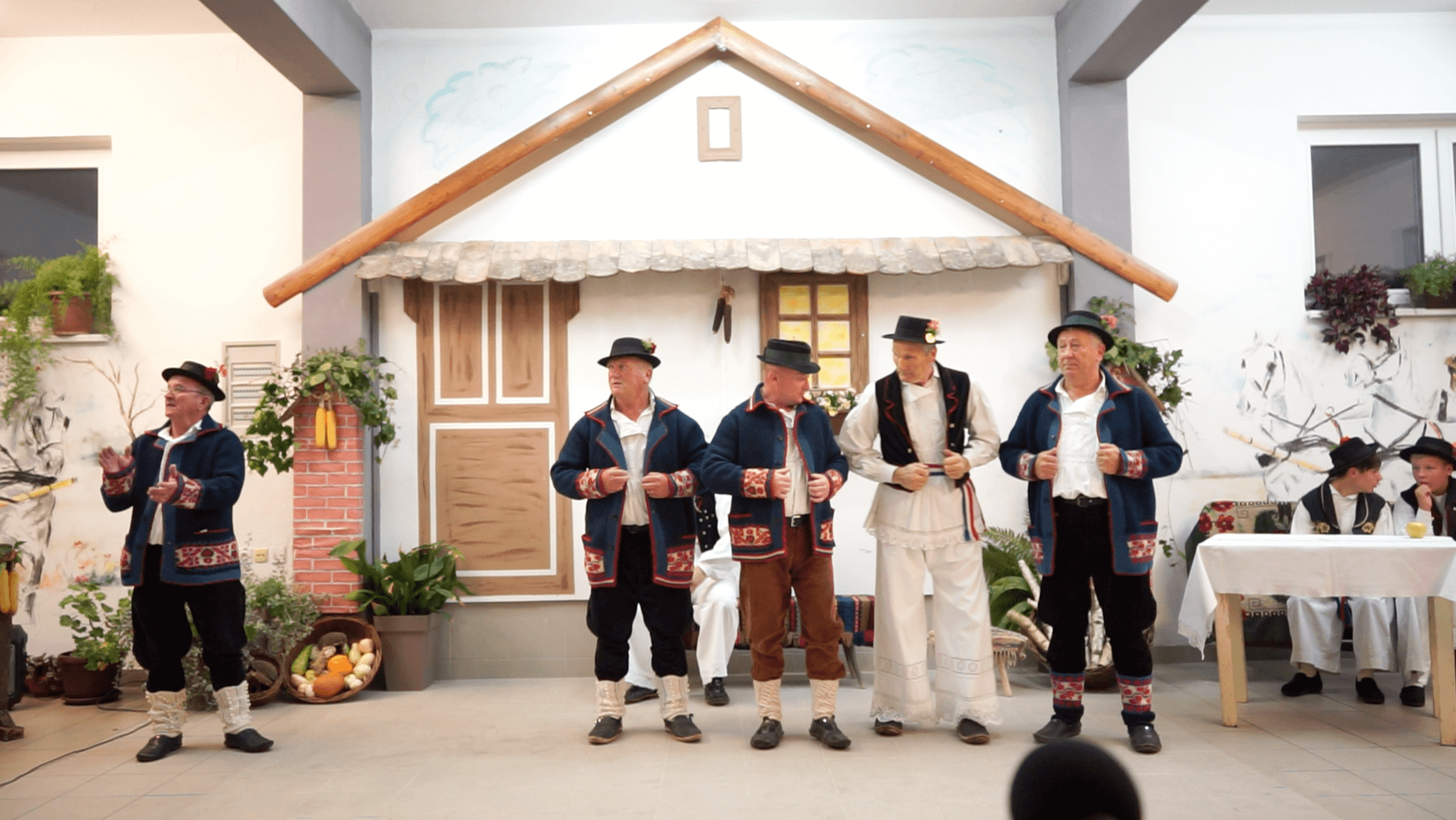
One of the manifestations celebrating the cultural heritage of Cerić and Slavonia, (photo credit: Vedran Čuljak)
As we know, Slavonia lost a lot of its residents in recent years, do you think that factor will affect your manifestations?
I don’t think so. Residents of Cerić notice our work as our guests as well. For example, we had a group of school children coming to our village as part of their trip, it was some kind of Vinkovačke Jeseni program and let’s just say the children weren’t that positive coming here. Why? Because they didn’t know what Cerić is, never heard of it and of course, they’re just not interested in those places, what can Cerić offer to them? However, after we hosted them nicely, organized nice lunch, their teacher, who was in charge, told us that this is the first time in her career that the children didn’t want to go home, they didn’t want to enter the bus and go. I know it’s a small sample but everyone who comes here, goes back home happy and they come back every year. There is still interest and to me, it seems it’s growing in the last few years.
Does that mean that there are successors and willing children to continue doing what you started? Promoting and persevering Slavonian cultural heritage?
Definitely! More and more children realized villages' worth, their traditions, and cultural heritage. Cerić and its residents are unbelievably close and connected, while other villages talk about the alienation of their residents from their heritage, we prosper every year more and more. When a child puts on our traditional folk costume (šokačku nošnju) and when you look at the photos of their ancestors in the same costumes, those children are vivid pictures of their predecessors, great grandmothers, great grandfathers, only the hair and clothes changed. Everything stayed the same. There are successors and always will be. They will never disappear!
Thank you Željko for your time! Can you recite one of your original Slavonian poems for the TCN readers?
From the poem "Slavonia, Mother"
"When I leave my homeland at dawn
I carry in my eyes a memory far from
far from the eye, to the heart, it's also hard
I will return once through tears, I said
.....
We'll meet again under the old oak
when the years close my dreamy eyes
until then I love you and always think of you
in my dream, almost every night I dream about you."
Events celebrating Slavonian cultural heritage mentioned in this interview are held in Cerić on the 24th of June "Evenings with Poetry" and the 2nd of October "Yearly Concert of Folklore Society "Slavko Mađar". If you're ever close and for instance, ever come to "Vinkovačke Jeseni", visit Cerić and their events, Slavonia, as always will welcome you with open arms.
For more, check out Made in Croatia.
Croatian Traditional Jewellery: Istria's Medieval Earrings, Rediscovered
February 25th, 2022 - Medieval earrings discovered on several archaeological sites in Istria served as inspiration for authentic souvenirs: beautiful replicas in silver and gold, made by local artisans
Our ancestors seem to have loved shiny things as much as we did: traditional garb in all parts of Croatia included precious jewellery pieces such as earrings, bracelets, brooches and pendants.
Some date back to medieval, ancient or even prehistoric times, and are nowadays displayed as museum exhibits. Others have stood the test of time, with traditional motifs passed down from generation to generation and remaining popular accessories to this day.
And then there’s some traditional jewellery that falls into both these categories. Medieval earrings found on several archaeological sites in Istria were rediscovered in recent times and recreated with beautiful replicas in silver and gold, made by local artisans and whoheartedly embraced by the public.
The initiative to revive the ancient heritage of Istria in the form of jewellery largely came from goldsmith Klaudija Vorić, owner of Claudia Zlato jewellery shop in Svetvinčenat, now closed. Since the early 2000s, Vorić had been making jewellery inspired by traditional Istrian symbols. About ten years ago, she launched the initiative to make replicas of historic earrings in order to create high quality souvenirs for each given destination in cooperation with local authorities and relevant tourist boards. Vorić was the one responsible for the revival of Žminj, Buzet and Barban earrings on this list, and it's only right we give credit where credit is due.
Join us on a little themed tour of Istria as discover accessories of times past that now have their modern versions, readily available to all who wish to wear a piece of history.
Žminj earrings / Žminjski rićin
It’s said that all the roads in Istria lead to Žminj, so it only makes sense to start our journey in this picturesque inland town.
Earrings and rings were uncovered at the early Croatian cemetery in Žminj, showing that the local women used to wear jewellery as early as in the 9th century. How’s that for tradition?

The earrings found at the necropolis were part of the rural folk costume worn in the Žminj area in the 9th and 10th centuries. They were made of silver and bronze and are grouped into several categories according to design and origin, with the most prominent type featuring so-called ‘strawberries’, hollow granules made of silver with elements of filigree and mesh. Some feature closed hoops, pointing to the fact they were most likely worn interwoven in hair or looped on hair strings.
Nowadays, the original finds are kept at the Archaeological Museum of Istria in Pula. They inspired a beautiful authentic souvenir, the Žminjski rićin (Žminj earring), designed after the medieval pieces and slightly modified to fit modern standards of jewellery wear.
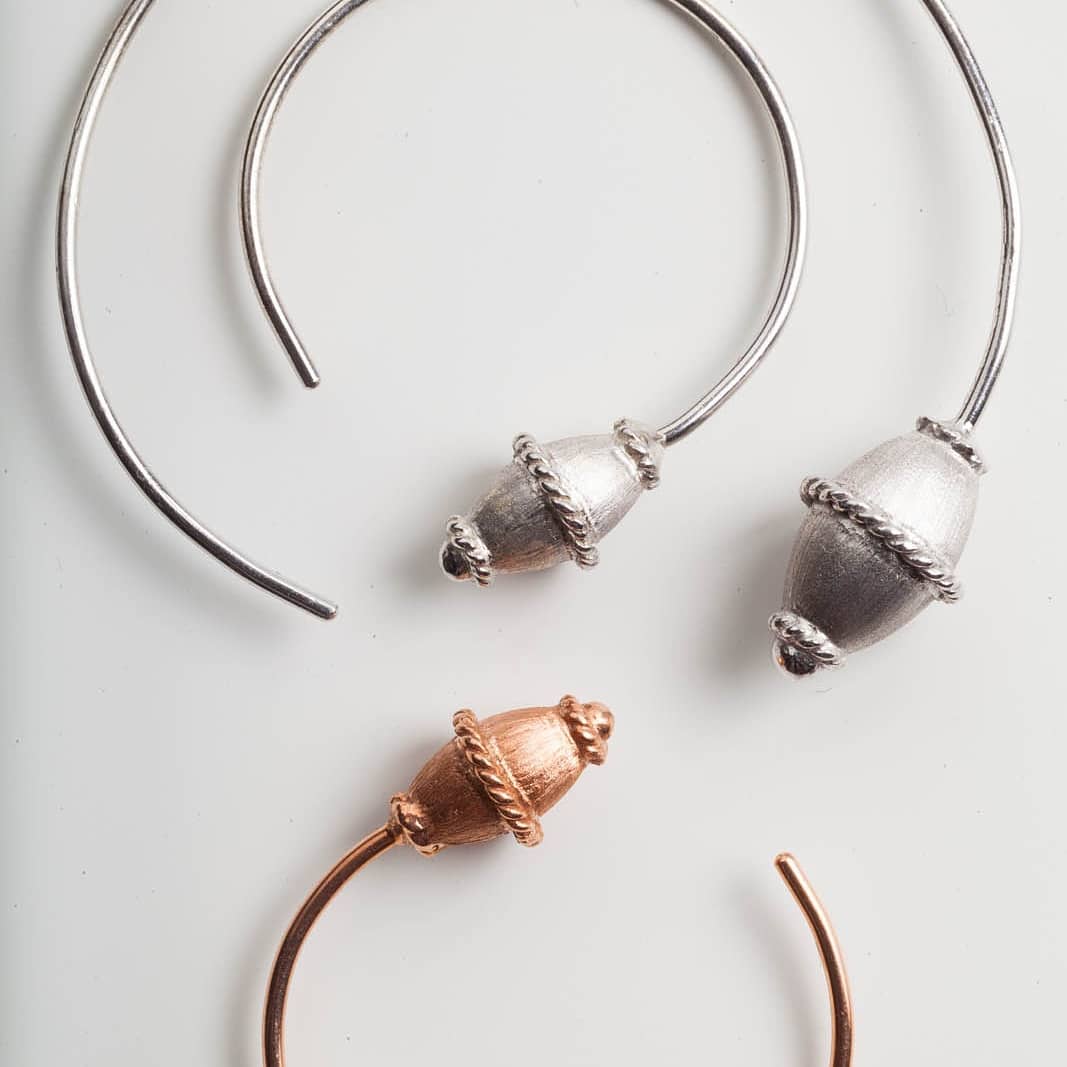
The gorgeous pieces are nowadays made of silver and gold, and are manufactured in Pula by David jewellery.
In Žminj, earrings and rings are available for sale at the floral studio Heidi as a unique tourist souvenir, complete with a leaflet introducing the history of the Žminj jewellery in three languages.
 Žminj rings / Zlatarna David Facebook
Žminj rings / Zlatarna David Facebook
Barban earrings / Barbanski rančin
Earrings dating to the 11th century were unearthed in the small town of Barban. The medieval earrings have the form of a hoop with three small beads adorning the bottom part.
Similar to the ones found in Žminj, they were determined to be a part of folk costume typical for the period between the 11th century, when Istria was a part of the Holy Roman Empire, to the beginning of the 14th century when the region was taken over by the Venetian Republic.

Medieval Barban earring / Archaeological Museum of Istria
The initiative to bring the traditional Barban earrings into the modern era was also launched by Claudia Zlato jewellery, with the project devised by Jasminka Benazić and executed in cooperation with the Archaeological Museum of Istria, the Municipality of Barban and the Barban Tourist Board.
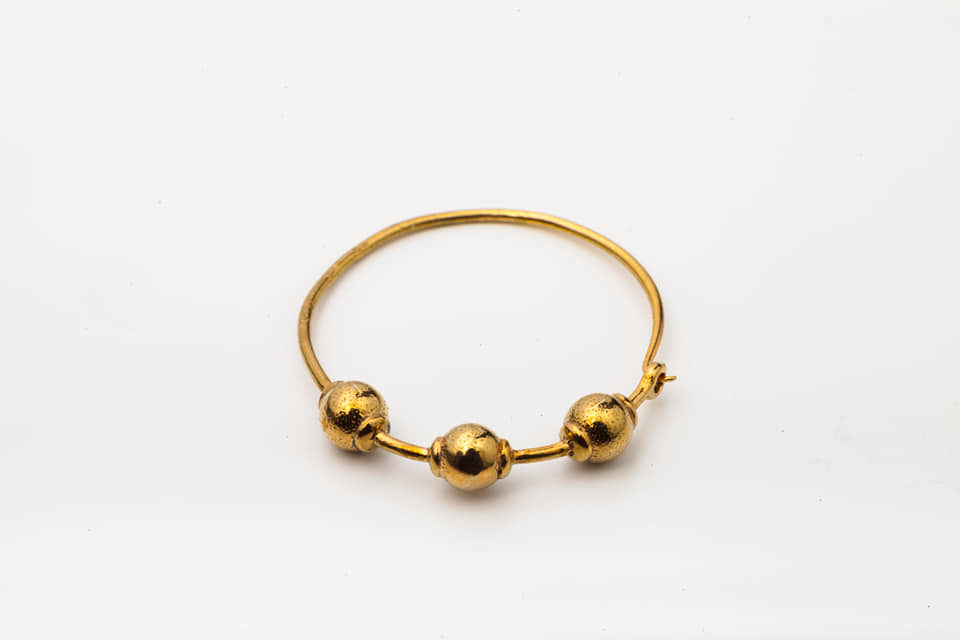 Barban earring / Zlatarna David Facebook
Barban earring / Zlatarna David Facebook
The result are beautiful wearable earrings, made in several sizes and materials and inspired by the cultural heritage of Barban.
Dvigrad earrings / Rančin Dvegrajka
On to Dvigrad, a ruinous medieval town in Limska Draga valley, where two unique types of earrings were discovered, made of bronze and dating to the 9th century.
Both types are simple hoops, one with a thin wire wrapped around the bottom part (see image below), the other adorned with a bead. Several other kinds of earrings were found in the Dvigrad area, but since they share features with various types discovered on archaeological sites elsewhere in Istria, it was decided to only make replicas of the two designs unique to Dvigrad.
The wearable souvenirs are made by David jewellery from Pula, whose owner, goldsmith Luiđi Đinić, said it takes up to five hours to make a single pair. The delicate hoops are entirely handmade, and available in silver, silver-gilt, and silver gilded rose gold versions.
Like the other artefacts, the historic Dvigrad earrings are kept at the Archaeological Museum of Istria and were declared a cultural asset of the Republic of Croatia back in 1968.
Buzet earring / Buzetska naušnica
Delicious truffles aren’t the only precious thing found in the north of Istria, as the history of the hilltop town of Buzet and its environs goes all the way back to the Bronze Age.
It doesn’t come as a surprise that beautiful historic jewellery was discovered in Buzet as well, a type of bronze earring dating to the 7th century and known as the Buzet earring in archaeological literature.
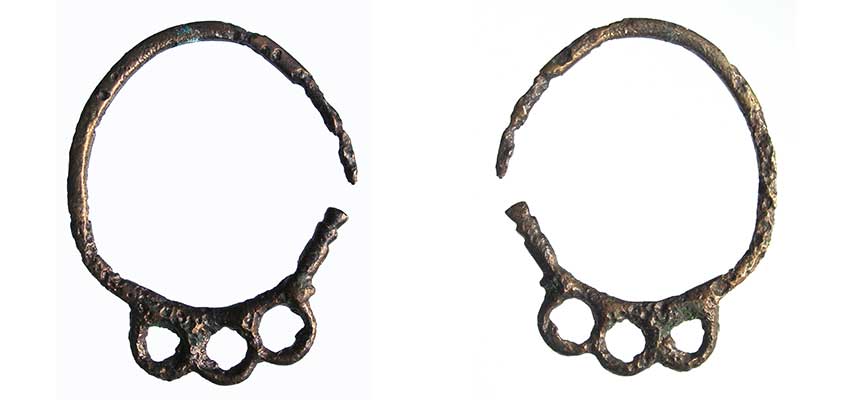 Medieval Buzet earrings / Buzet Tourist Board
Medieval Buzet earrings / Buzet Tourist Board
Bronze earrings are most commonly found at the early medieval burial grounds of the native population and the Illyrian-Celtic people who inhabited the area between Buzet and the west coast of Istria.
The original pieces are kept at the Regional Museum of Buzet, and a silver replica was created as an authentic souvenir of Buzet. Two kinds are available, one being a near identical copy of the medieval earrings, other slightly modified and equipped with a clasp to be more easily wearable.
 Buzet earring / Buzet Tourist Board
Buzet earring / Buzet Tourist Board
Umag earrings / Umaška naušnica
We’ll end our little tour in Umag, a coastal town in the north-west of Istria. Although best known for the ATP tournament, Umag has much more to boast, including priceless historic finds such as the so-called Umag earring.
The bronze earring is shaped as an elliptical hoop adorned with three beads and a large engraved pendant, altogether cast in a one piece mold. It was found during archaeological research conducted in Umag in 2005, at the ruins of an early medieval church that burned down in the 9th century.
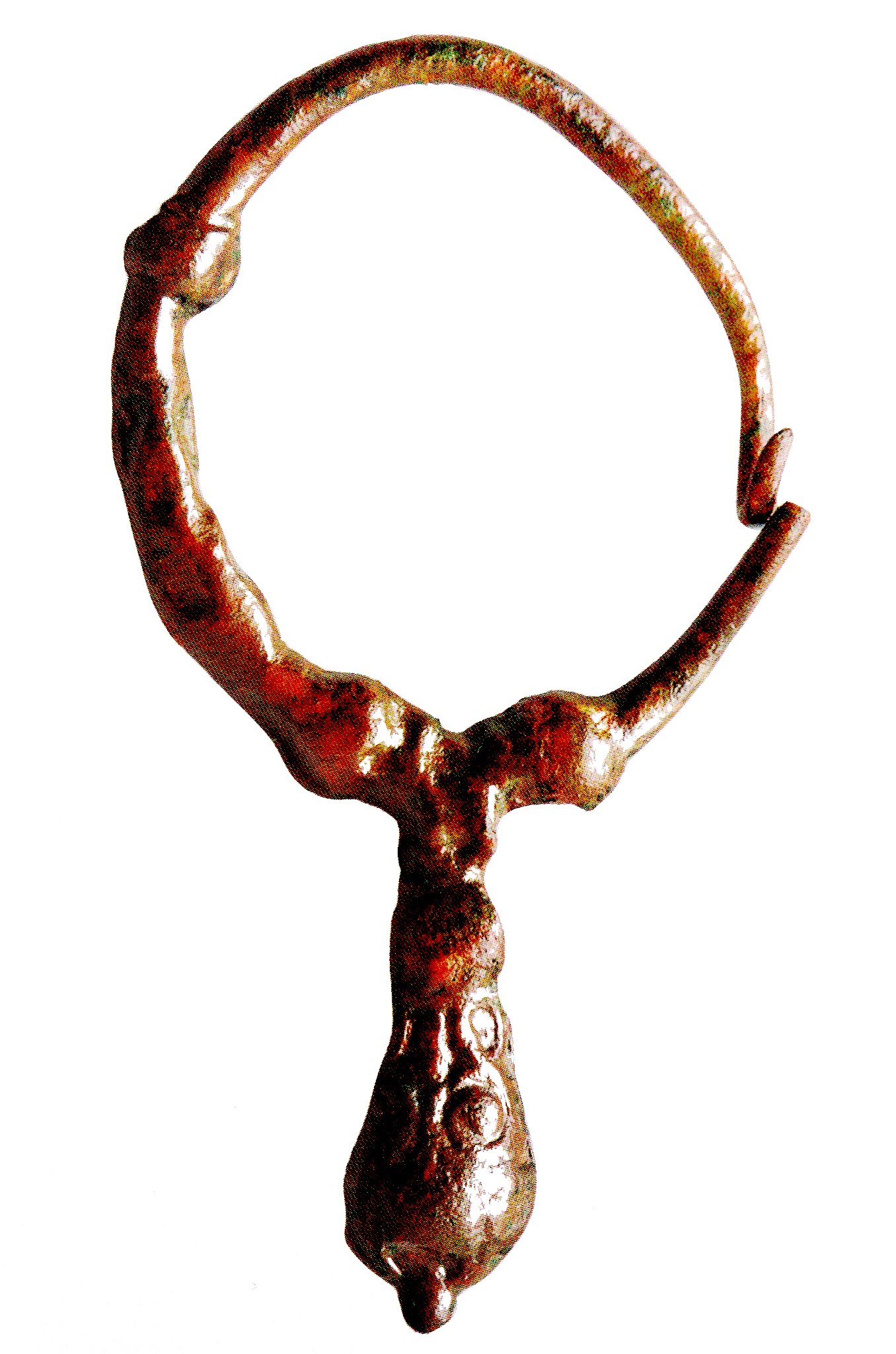
A silver replica was made by the local goldsmith and filigree master Njaci Široka, creating an original Umag souvenir that is available for sale in his shop.
Documents Confiscated From Dubrovnik Archives Returned
ZAGREB, 23 June, 2021 - Documents that were confiscated from the Dubrovnik State Archives and were found in the Salzburg Diocese Archives were handed over on Wednesday in the presence of Croatia's Minister of Culture and Media Nina Obuljen Koržinek and Croatia's Ambassador to Austria Danijel Glunčić.
The operation ended successfully with the return of Croatia's cultural heritage, Minister Obuljen Koržinek said, noting this isn't the first or last time this has been done.
Ambassador Glunčić underscored that the Salzburg Diocese had full understanding that the medieval documents could not be considered to be part of Austria's or Salzburg's history.
The documents involved are two pontifical documents which the diocese was immediately prepared to return to Croatia, and this was also approved by Austria's state authorities, he said, adding that the documents will be placed in Dubrovnik's Archives.
Police working on issues related to cultural heritage
Police Director Nikola Milina said that the police were working on cultural heritage issues, adding that they have had good results so far.
A soon as the information was released, the Croatian police contacted the police in Austria and the documents were quickly identified which led to them being returned, he said.
Digitalisation to facilitate return of other missing documents
Director of Dubrovnik State Archives Nikolina Pozniak is convinced that digitisation will contribute to other documents that have gone missing from the archives and other institutions to be returned.
The head of the archive's collection, Zoran Perović, explained that the documents returned today are two pontifical bulls dated 1189 and 1252. The first notes that the Pope is deploying Archbishop Bernard to Dubrovnik while the other bull refers to the appointment of an archbishop to be a judge in a dispute between the Bar and Dubrovnik Archdioceses.
For more about politics in Croatia, follow TCN's dedicated page.
Minister Nina Obuljen Koržinek Confident of Prompt Reconstruction of Quake-Damaged Monuments
ZAGREB, 8 April, 2021 - Culture Minister Nina Obuljen Koržinek said on Thursday the most important thing in the reconstruction of the cultural heritage was to reinforce and repair all monuments in a short time and that the first allocation would help to carry out all urgent works in 18 months.
The first allocation at our disposal is €680 million from the European Solidarity Fund, she told the press, saying that the recently outlined national recovery and resilience plan included reconstruction funds.
Croatia also has at its disposal funds approved by the World Bank, she said, adding that she also expected the approval of an allocation following last December's earthquake in Sisak-Moslavina County.
She said the damage to the cultural heritage in Zagreb following the March 2020 quake was estimated at €7 billion.
The reconstruction of complex monuments such as Zagreb's Mirogoj cemetery would take years and the necessary funds will be raised from various sources, the minister said.
She said her ministry had received more than 130 acceptable reconstruction applications and that contracts had been signed for a little over 40 monuments, including sacral and public buildings.
She added that public procurement was already under way and that over the past year experts from the ministry and Zagreb's faculties of civil engineering, geodesy, and architecture had completed the required documents for all monuments.
The first objective is to reinforce the buildings to prevent them from being a threat and deteriorating, the minister said.
For more about politics in Croatia, follow TCN's dedicated page.
Minister Nina Obuljen Koržinek Says Mirogoj Cemetery One of Seven Most Endangered European Localities
ZAGREB, 8 April, 2021 - Zagreb's Mirogoj cemetery complex is one of the seven European most endangered monument localities in 2021, Culture and Media Minister Nina Obuljen Koržinek said at a news conference on Thursday.
The Culture and Media Ministry, in cooperation with the City of Zagreb, the City Institute for the Conservation of Cultural and Natural Heritage and the Zagreb Holding multi-utility conglomerate nominated the cemetery for the European Seven Most Endangered Programme, taking into account its specificity and value as the most important multiconfessional cemetery in Croatia and an exceptionally valuable cemetery at the European level, as well as the huge damage caused to it by the March 2020 earthquake, the minister said.
She recalled that the programme, implemented since 2013 by Europa Nostra in cooperation with the European Investment Bank Institute, each year puts emphasis on seven European localities.
That way experts and funds are mobilised so that together we can renovate the European cultural heritage, said Obuljen Koržinek.
She noted that a number of European experts, notably earthquake reconstruction experts, had offered various forms of help over the past year and that they would all be involved, notably in complex reconstruction projects.
"The preliminary work on the Mirogoj complex alone, to be financed from the European Solidarity Fund, has been estimated at HRK 97 million," she said, adding that this includes emergency repairs acceptable for financing under the European Solidarity Fund.
Those funds have been approved, documents are being collected and work will start relatively soon, she said, noting that it was clear to everyone that the renovation of Mirogoj would be a long-standing project requiring great professional engagement considering that the cemetery had not been renovated since its construction.
She said that at today's Europa Nostra presentation it was said that everyone would mobilise to help Croatia collect the necessary funding.
The other six most endangered monuments and localities of cultural heritage in Europe in 2021 are the Achensee Cog Railway (Tyrol, Austria), Five Southern Aegean Islands (Greece), Giusti Garden in Verona (Italy), Dečani Monastery (Kosovo), the Central Post Office in Skopje (North Macedonia) and the San Juan de Socueva Chapel and Hermitage (Cantabria, Spain).
For more about politics in Croatia, follow TCN's dedicated page.
Meet Projects that will Change the Face of Makarska Tourism
February 5, 2019 - Makarska has recognized the value of cultural heritage as an outstanding potential for the development of selective types of tourism.


